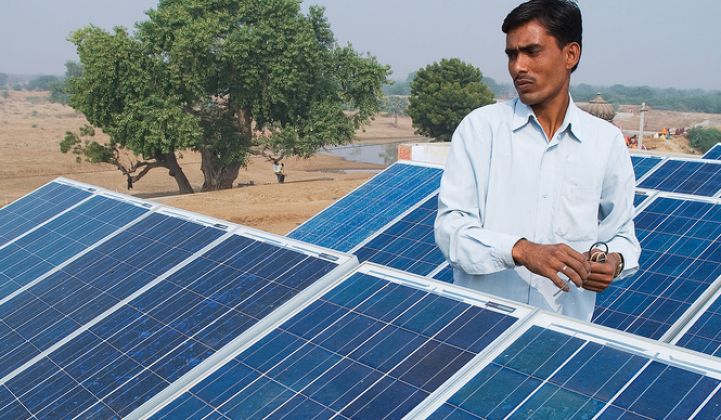For the first time ever, India is putting out the call for energy storage developers.
The state-run Solar Energy Corporation of India (SECI) is seeking bids for a 750-megawatt solar park at Ananthapuramu in Andhra Pradesh. In order to supplement the massive series of projects, SECI is looking to procure 100 megawatts of storage capacity.
It’s a small step for solar storage in a country that currently has little capacity. But if batteries are regularly added to future tenders, it could add up to a large market, given India’s ambitious solar targets.
The government is planning 20 gigawatts of solar installations over the next few years and 100 gigawatts by 2020 or 2022 -- amounting to a $100 billion opportunity for solar, according to Ernst & Young's renewable energy attractiveness index.
Madhavan Nampoothiri, founder of RESolve Energy Consultants, thinks solar-plus-storage will benefit.
“The opportunity is huge in India, mainly in the rooftop/off-grid space,” he said. “Power outages are rampant in India, and energy storage can help reduce the outages. On the utility-scale projects side, grid balancing and grid integration become increasingly important in order to counter the [intermittent] nature of solar.”
Large companies are preparing to do business in the sector. General Electric recently announced that its energy consulting business was chosen by IL&FS, one of India's leading infrastructure developers and financiers, to examine the feasibility of integrated wind, solar and energy storage projects at sites in Andhra Pradesh and Gujarat.
“Energy storage can be particularly helpful for integrating variable renewable generation in India since the technical infrastructure and market mechanisms available at the disposal of many other power grids are not yet available in the country,” said Sundar Venkataraman, GE Energy Consulting’s technical director. “As the costs start to come down, energy storage will become an integral part of India’s grid.”
IL&FS, also one of the biggest independent wind power producers in India, last year secured funding from the United States Trade and Development Agency (USTDA) to look into utility-scale integration of wind, solar and storage in India. The grant is part of $2 billion in trade investment that USTDA has earmarked for renewable energy projects in India.
GE’s contribution to the research will include designing a power plant combining wind, solar, energy storage and controls. The company will then look at the costs incurred and build a business plan in order to make the project commercially viable.
At this stage, it is unclear what battery chemistries will dominate in India's market. It will likely be lithium-ion; however, according to Madhavan Nampoothiri, there will be a place for vanadium redox flow batteries in the longer term.
For example, SunEdison ordered 1,000 vanadium storage systems from Imergy last year for use in solar-powered microgrids in rural India.
Despite its bold plans, India doesn’t have much solar to speak of yet. At the moment, its 3 gigawatts of installed solar account for only 1 percent of the country’s total generating capacity. To put that into perspective, China and Germany already have roughly 40 gigawatts each.
India's storage sector may depend on how quickly solar scales up in the country.



